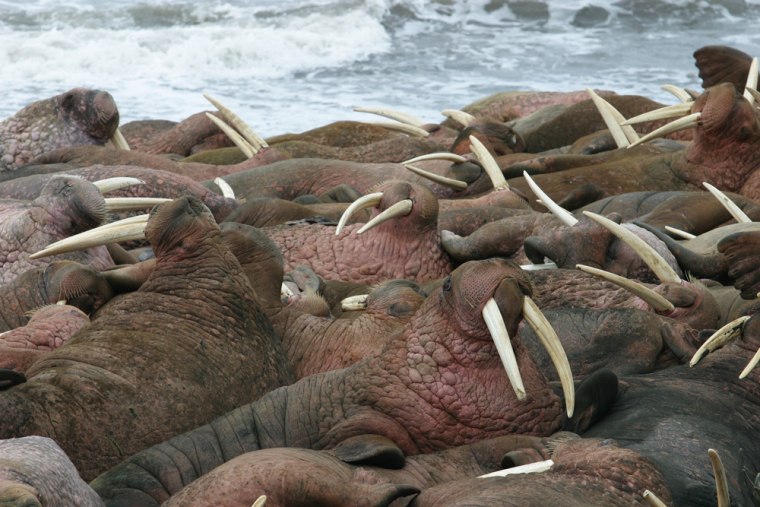Thousands of walruses since late summer have congregated in areas on Alaska's northwest shore, a phenomenon likely connected to record low Arctic sea ice and warming temperatures.
Joel Garlich-Miller, a walrus expert with the U.S. Fish and Wildlife Services in Anchorage, said animals began showing up on shore in late July, a month earlier than usual. By August, several thousand animals — far more than normal — were bunched up in a few areas from Barrow, America's northernmost community, to Cape Lisburne, about 300 miles to the southwest on the Chukchi Sea.
"It's raising a bunch of conservation issues for us," Garlich-Miller said.
The agency's immediate concern is that groups of walruses congregated on land are susceptible to additional human contact, whether a low-flying airplane or a hunter's boat, that could cause panic in the group, setting off a deadly stampede to the water.
But having animals concentrated on land instead of the vast expanse of the Arctic ice pack also raises stress issues, said Chad Jay, a U.S. Geological Survey biologist.
Food concern
Walruses on shore may be forced to swim farther to forage, expending more energy. Researchers would expect increased mortality to calves, Jay said, if they try to stay with their mothers during feeding rather than resting on a platform of sea ice over feeding grounds.
"You can imagine access to traditional foraging areas is diminished," Garlich-Miller said. "That is cause for concern."
The Fish and Wildlife Service has no evidence that the walruses have suffered nutritional stress or disease, said Bruce Woods, an agency spokesman.
The agency has received anecdotal information from hunters that some animals appear thin but not emaciated or endangered, Garlich-Miller said. As has happened in the last few years, the agency has receive reports of orphan calves.
Walruses also have been spotted at Kaktovik 325 miles southeast of Barrow on the Beaufort Sea, far east of their normal range, Garlich-Miller said.
The agency has received assistance in monitoring walruses on shore from flights done on behalf of Shell Oil, which is monitoring walrus activity in the Chukchi Sea in advance of possible offshore petroleum exploration. At the agency's request, the company added a coastal component to its flights, Garlich-Miller said.
Visual counting of walrus is notoriously difficult because the animals congregate so close together on shore. The agency expects a more accurate count after analyzing digital photographs.
Some tracked with tags
A USGS research project to study how walruses would react to diminished sea ice tagged nine animals with satellite radio transmitters near the end of June off Barrow, Jay said.
"We wanted to track walruses to determine what they do when the sea ice retreated over the deep Arctic Basin," he said.
The tagged animals stayed near shore using small remnants of sea ice and did not follow the ice edge north, he said. When those small floes finally disappeared, he said, the walruses were swimming south.
"Apparently they are now hauled out on the shores of Alaska," he said.
The Alaska haulouts are following a trend of animals on the other side of the Chukchi Sea, said Jay and Garlich-Miller. Russian research observers have seen dramatic increases of animals on shore, sometimes numbering in the tens of thousands and now including females with young.
"Usually they stay with the sea ice," Jay said.
Walruses breed in the Bering Sea in the winter time. Calves are born in late April or early May.
In spring, when ice retreats, males generally remain in the Bering Sea. But females migrate north with their pups through the Bering Strait and traditionally stay with the ice edge in the Chukchi Sea.
Walruses feed on clams, snails and other bottom creatures. As the ice edge moves over the relatively shallow continental shelf, females can nurse their calves on ice and reach productive feeding areas as the ice edge moves north.
Ice edge in water too deep
However, extreme ice retreats in recent years have put the ice edge far north of the continental shelf, over water that's too deep for the females to feed.
A maximum dive for a walrus to scour the sea bottom is about 630 feet and the Arctic Basin can be several thousand feet deep or more.
The National Snow and Ice Data Center at the University of Colorado at Boulder reported that Arctic sea ice during the 2007 melt season plummeted to the lowest levels since satellite measurements began in 1979.
"This year that platform melted away from underneath them pretty quickly," Garlich-Miller said.
September is the end of the melt season.
The average sea ice extent for September this year was 1.65 million square miles, the lowest September on record, shattering the previous record for the month, set in 2005, by 23 percent.
The September rate of sea ice decline since 1979 is now about 10 percent per decade, or 28,000 square miles per year, according to the center.
The center attributes the shrunken ice pack to effects of greenhouse warming plus unusual atmospheric patterns.
The Fish and Wildlife Service is working with the Federal Aviation Administration and Alaska coastal communities near the haulouts to minimize human contact with the animals, Garlich-Miller said.
It may take until spring to determine if there are animal deaths associated with the Alaska haulouts, Garlich-Miller said.
Walruses are expected to remain on shore until they move south as the Chukchi Sea freezes in November. Information from flights will be limited by snow cover and the Alaska winter darkness.
"We may have to follow up this next spring to see what the final chapter of this was," Garlich-Miller said.
